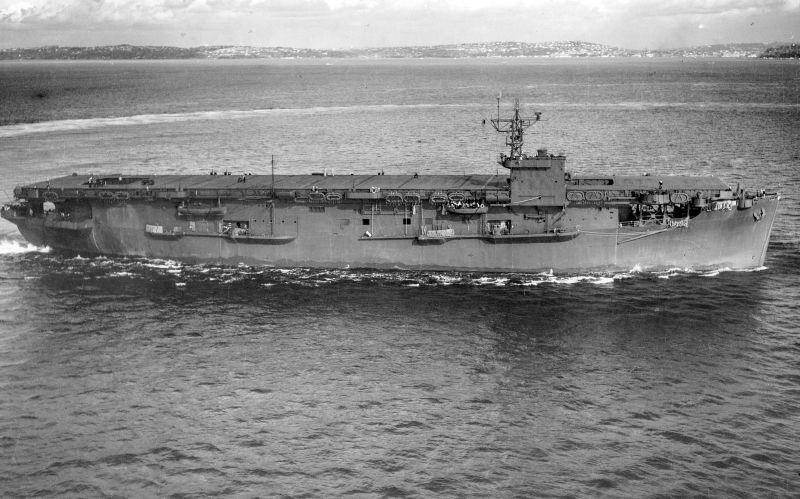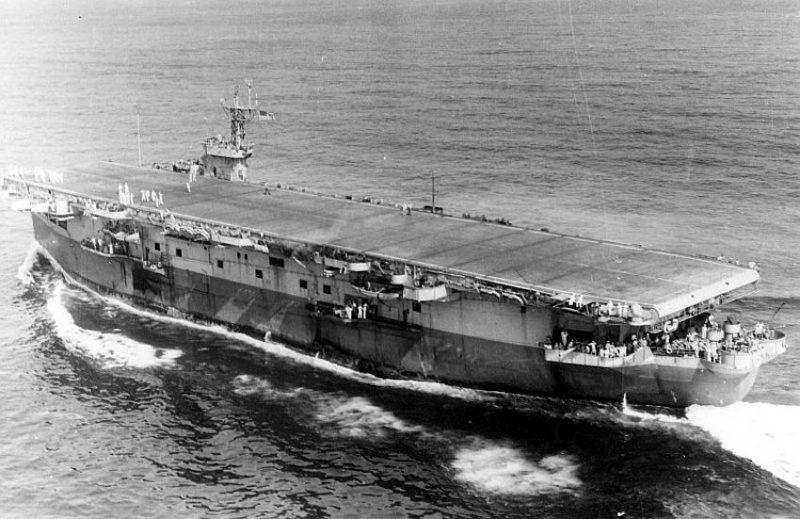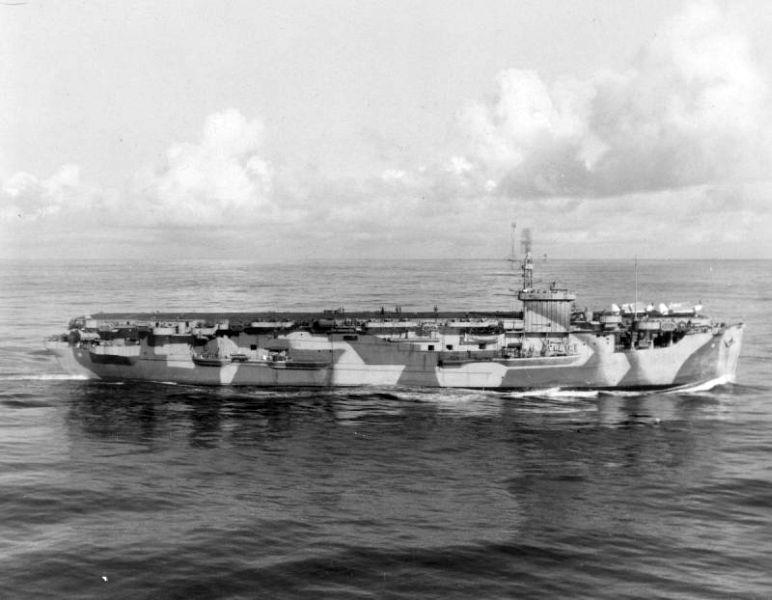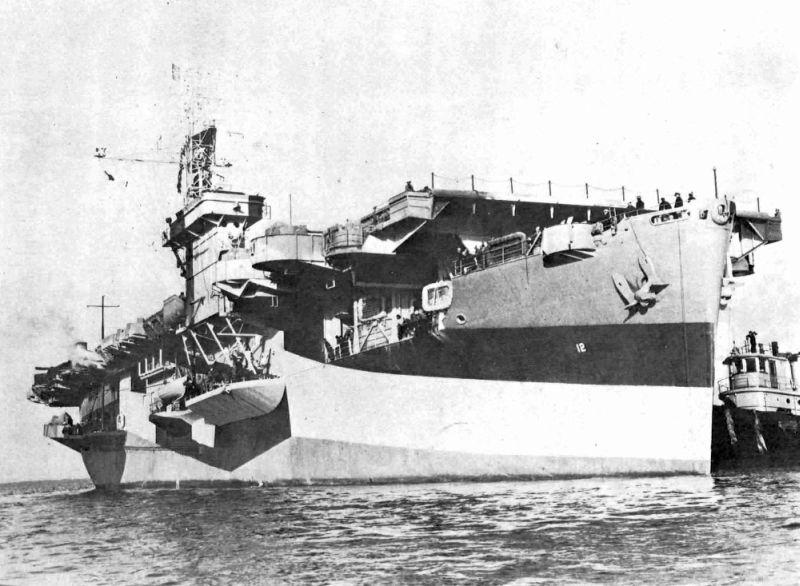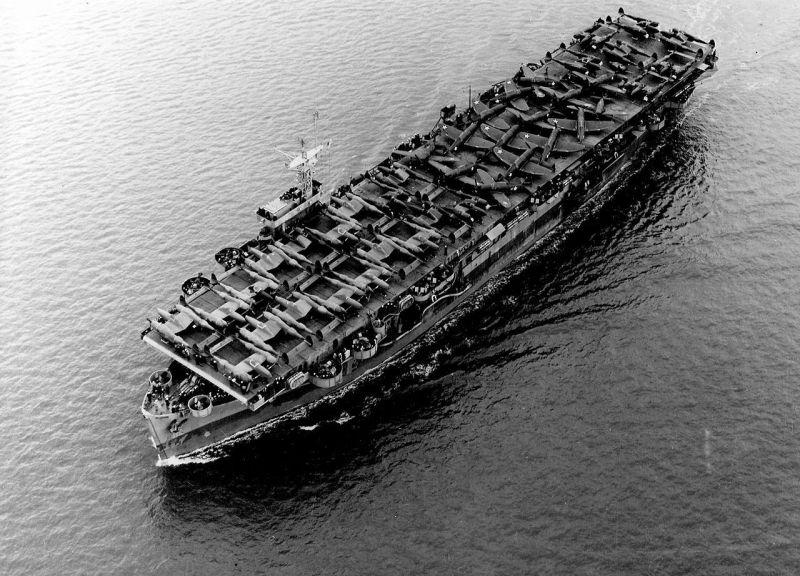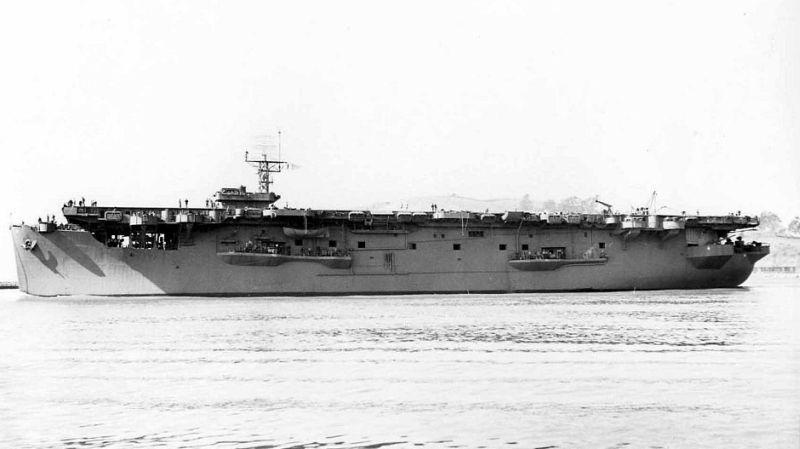Introduction
The Bogue-class escort aircraft carriers were designed on the basis of the US Maritime Commission's C3-type merchant cargo vessel, in a similar way as USS Long Island, USS Charger and the British HMS Archer and the Avenger-class escort carriers. However, with the Bogue-class ships, the civilian shipyards took the imminent conversion into an aircraft carrier into account from the moment they were laid, based on the lessons learned from the shortcomings of earlier converted auxiliary aircraft carriers. A number of improvements were therefore immediately implemented during construction. The most important of these was replacing the diesel engines with steam turbines. The diesels themselves were not so much the issue, but the electromagnetic clutches, which were supposed to ensure that the engines were coupled to the single propeller shaft using gears, caused many problems. Furthermore, the new ships had multiple compartments separated by watertight bulkheads. The hangar deck was also almost completely closed-off and the ships were provided with a second aircraft elevator.
The 45 ships of the Bogue class were built in two batches. The first batch consisted of 21 vessels, more than half of which were intended for the Royal Navy within the terms of the Lend-Lease Act and called the Attacker class. The second batch was built almost entirely at the expense of the British and called the Ameer class in the Royal Navy. However, because of the HMS Dasher accident (sunk by successive explosions inside the ship off the coast of Scotland on March 27, 1943, killing 379 of a total of 528 crew members), the British required major modifications to the Bogue-class ships. These included an extended flight deck, modifications to the hangar, accommodations and warehouses, internal communications, blackout options and anti-aircraft defences. They also demanded a different calibre of guns.
What annoyed the Americans most were the British requirements regarding the storage of aviation fuel. The aviation fuel tanks not only had to be smaller, but above all cylindrical in shape, double-walled and equipped with pressure relief valves and static discharge systems. Furthermore, they were not allowed to be directly connected to the ship’s supporting structure and should be located below the waterline as much as possible. To implement the adjustments, the escort aircraft carriers were sent in batches to the Burrard Dry Dock yard in Vancouver, Canada, before they were delivered to the British. Due to British demands, the Americans no longer wanted to supply escort aircraft carriers to the Royal Navy. The successors to the Bogue-class and Sangamon class (1942) escort aircraft carriers became the Casablanca-class carriers and of these fifty vessels, none were intended for the British.
Unique amongst the Bogue class ships was USS Prince William (CVE-31). Unlike the other escort aircraft carriers of the Bogue class, this ship was part of the second batch and the only one that was not transferred to the Royal Navy. Therefore, the vessel retained the specifications of the first group of American ships of the Bogue class and is considered by historians to be part of that class. The Bogue-class carriers were named after various sounds and inlets situated along the American coastline.
Class overview
| Hull classification(s) and number(s) | Keel laid | Launched | Commissioned | |
| USS Bogue | AVG-9, ACV-9, CVE-9 | October 1, 1941 | January, 1942 | September 26, 1942 |
| USS Card | AVG-11, ACV-11, CVE-11 | October 27, 1941 | February 27, 1942 | November 8, 1942 |
| USS Copahee | AVG-12, ACV-12, CVE12 | June 18, 1941 | October 21, 1941 | June 15, 1942 |
| USS Core | AVG-13, ACV-13, CVE-13 | January 2, 1942 | May 15, 1942 | December 10, 1942 |
| USS Nassau | AVG-16, ACV-16, CVE-16 | November 27, 1941 | April 4, 1942 | August 20, 1942 |
| USS Altamaha | AVG-18, ACV-18, CVE-18 | December 19, 1941 | May 22, 1942 | September 15, 1942 |
| USS Barnes | AVG-20, ACV-20, CVE-20 | January 19, 1942 | May 2, 1942 | February 20, 1943 |
| USS Block Island | AVG-21, ACV-21, CVE-21 | January 19, 1942 | June 6, 1942 | March 8, 1943 |
| USS Breton | AVG-23, ACV-23, CVE-23 | February 25, 1942 | June 27, 1942 | April 12, 1943 |
| USS Croatan | AVG-25, ACV-25, CVE-25 | April 15, 1942 | August 1, 1942 | April 28, 1943 |
| USS Prince William | CVE-31 | May 18, 1942 | August 23, 1942 | April 9, 1943 |
Technical specifications
| Shipyard: | Seattle-Tacoma Shipbuilding Corporation, Washington |
| Length overall: | 141.7 meter |
| Flight deck: | 134 x 26.8 meter |
| Beam max.: | 21.2 meter |
| Draft: | 7 meter |
| Displacement (standard): | 8,400 tons |
| Displacement (full load): | 16,620 tons |
| Powerplant: | 2 x geared steam turbines and 2 x boilers |
| Power capacity: | 8,500 pk |
| Propellers: | 1 |
| Bunkerage: | 3,260 tons fuel oil |
| Range: | 26,000 nmi at 15 knots |
| Maximum speed: | 18 knots |
| Complement: | 908 crew including air group |
| Armament: | 2 x 13cm guns, 4 x 2 40mm and 10 x 20mm anti-aircraft machine guns |
| Armour: | None |
| Flight deck facilities: | 2 x centered hydraulic elevators, 1 x hydraulic catapult, 9 x arresting wires |
| Aircraft: | 12 x Grumman F4F Wildcat fighters and 9 x Grumman TBF Avenger torpedo bombers |
All Bogue-class ships were classified as auxiliary aircraft carriers (ACV) on 20 August 1942 and as escort aircraft carriers (CVE) on 15 July 1943. The carriers of this class that survived the war and subsequently included in the reserve fleet were given the designation CVHE of helicopter carrier on June 12, 1955. However, this was only an administrative reclassification because the ships simply remained mothballed.
Definitielijst
- torpedo
- A weapon of war. A cigar shaped body fitted with explosives and a propulsion and control mechanism. Intended to target after launch a nearby enemy ship and disable it by underwater explosion.
USS Bogue
The Bogue was laid up as Steel Advocate by the Seattle-Tacoma Shipbuilding Corporation, Washington. On May 1, 1942, the C3 type merchant ship under construction was requisitioned by the US Navy. During the war, the escort aircraft carrier was part of an anti-submarine task group during convoy voyages as well as an aircraft transport ship in the Atlantic Ocean. On November 30, 1946, the Bogue was taken out of service and included in the reserve fleet. On March 1, 1959, the Bogue was sold for scrapping to Japan, where the ship was dismantled in December 1960.
USS Card
The Card was planned as an aircraft carrier and was not given any merchant navy name. The Card initially served as an escort ship and as a submarine hunter until the vessel was used as a training ship. During the final years of the war, USS Card served in the Pacific. From May 3, 1946, to July 1, 1958, the ship was mothballed until reactivated as a Utility Carrier (CVU-11). A few years later the Card entered service with the Military Sea Transport Service (MSTS) after which she was disarmed and operated by a civilian crew. The conversion for transport duties consisted of strengthening and expanding the bridge island, raising the chimneys and installing several large deck cranes. The ship was no longer in service with the US Navy but was chartered by the Navy as an aircraft transport ship and re-classified T-CVU-11 and from May 7, 1959, T-AKV-40 (Aviation Transport Carrier). On May 2, 1964, when moored dockside in Vietnam, the ship was sunk by an explosive charge planted by the enemy. After the ship had been repaired and re-floated, she returned to active service until finally decommissioned on March 10, 1970. In 1971, the vessel was sold for scrapping.
USS Copahee
The Copahee was completed at the Puget Sound Naval Yard in Bremerton, Washington, after the ship was requisitioned by the US Navy on February 8, 1942. The auxiliary carrier performed aircraft transport and combat duties in the Pacific. On July 5, 1946, the escort aircraft carrier was decommissioned and incorporated into the US Reserve Fleet until March 1, 1959. The Copahee was sold for scrapping in 1961.
USS Core
The Core was requisitioned by the US Navy on May 1, 1942, and deployed as an aircraft transport ship and anti-submarine fighter in the Atlantic Ocean. On October 4, 1946, the ship was taken out of service and mothballed. On July 1, 1958, the vessel was reactivated for service duties and re-classified as CVU-13, after which she was converted for transport duties and entered service with the MSTS as T-CVU-13. On May 7, 1959, the Core became an Aviation Transport (T-AKV-41). Ten years later, on November 25, 1969, the Core was finally withdrawn from service and sold for scrapping in 1971.
USS Nassau
The Nassau was requisitioned by the US Navy on May 1, 1942, and completed at the Puget Sound Naval Yard in Bremerton. The ship mainly served as an aircraft transport ship in the Atlantic Ocean. On October 28, 1946, the escort aircraft carrier was decommissioned and mothballed. The ship was written off on March 1, 1959, and sold to Japan for scrapping in 1961.
USS Altamaha
The Altamaha was also requisitioned by the American Navy on May 1, 1942, and completed in Bremerton as an auxiliary aircraft carrier. The USS Altamaha was used as an anti-submarine vessel on convoy voyages and as an aircraft carrier and training ship in the Atlantic Ocean. On September 27, 1946, the ship was taken out of service and incorporated into the reserve fleet. The vessel was written off on March 1, 1959, and sold for scrapping to Japan on April 25, 1961.
USS Barnes
It has not been established when the Barnes was requisitioned by the US Navy. The auxiliary aircraft carrier mainly served as an aircraft transport ship in the Pacific. The vessel was withdrawn from service on August 29, 1946, and struck from the Naval Vessel Register on March 1, 1959. The discarded ship was then sold for scrapping.
USS Block Island
The Block Island was requisitioned by the US Navy on May 1, 1942, and served as a transport ship and Anti-Submarine Warfare (ASW) Carrier in the Atlantic Ocean. USS Block Island was very successful as a submarine killer and her aircraft sank U-220 and U-1059 as well as, in collaboration with destroyers, U-801, U-66 and U-709. Ironically, USS Block Island itself was also sunk by a U-boat. On May 29, 1944, near the Canary Islands, U-549 managed to bypass all vessels of the escort carrier's escort and torpedo her. The Block Island was hit by three torpedoes and sank quickly, but six of her 957 crew could not be rescued. U-549 was sunk shortly after the attack itself by the destroyer USS Eugene E. Elmore and the escort destroyer USS Ahrens.
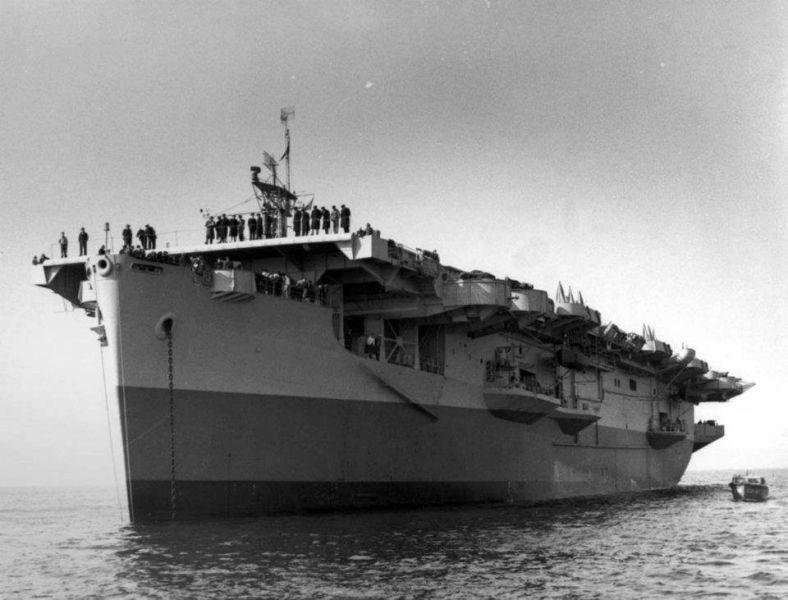
The USS Block Island was the only Bogue-class carrier that was sunk during the Second World War. Source: Navsource
Definitielijst
- collaboration
- Cooperation of the people with the occupying forces, more generally spoken the term for individuals who cooperate with the occupying force is collaborator.
- destroyer
- Very light, fast and agile warship, intended to destroy large enemy ships by surprise attack and eliminating them by using torpedoes.
- torpedo
- A weapon of war. A cigar shaped body fitted with explosives and a propulsion and control mechanism. Intended to target after launch a nearby enemy ship and disable it by underwater explosion.
- U-boat
- The German name for a submarine. German U-Boats (Submarines) played a very important role during the course of warfare until May 1943. Many cargo and passenger ships were torpedoed and sunk by these assassins of the sea.
USS Breton
The Breton was requisitioned by the US Navy on May 1, 1942, and was only used as an aircraft transport ship in the Pacific. On August 20, 1946, the vessel was withdrawn from service and incorporated in the reserve fleet. On July 1, 1958, the Breton returned to active service as Utility Carrier CVU-23 and later converted for transport duties. The aircraft carrier entered service with the MSTS as T-CVU-23 and from May 7, 1959, as T-AKV-42. The ship was written off on August 6, 1972, after being permanently taken out of service in 1971. It was then sold for scrapping.
USS Croatan
The Croatan followed the same path as her sister ship USS Breton. Her hull numbers after the war were successively CVU-25, T-CVU-25 and T-AKV-43. From October 1964 to May 1965, USS Croatan was used as an experimental ship by the NASA space agency. Fully equipped with radar, antennas and special rocket launchers, the vessel was deployed for launching Sounding Rockets to conduct aeronomy research. The Croatan was finally taken out of service on October 23, 1969, and written off on September 15, 1970. The ship was sold for scrapping in 1971.
Definitielijst
- radar
- English abbreviation meaning: Radio Detection And Ranging. System to detect the presence, distance, speed and direction of an object, such as ships and airplanes, using electromagnetic waves.
- rocket
- A projectile propelled by a rearward facing series of explosions.
USS Prince William
The Prince William was delivered as the first ship of the second batch of the Bogue-class aircraft carriers. The date on which the US Navy requisitioned the ship is unknown, but it was completed as an auxiliary aircraft carrier at Bremerton, Washington. Initially, the ship was deployed as an aircraft transport ship in the Pacific, but later it was transferred to the US Atlantic Fleet. On August 29, 1946, the aircraft carrier was decommissioned and incorporated into the Reserve Fleet. On March 1, 1959, the vessel was written off and sold to Japan for scrapping in March 1961.
Epilogue
The American escort aircraft carriers of the Bogue class were the last to be built from merchant ships. The British, however, continued to convert civilian ships into auxiliary aircraft carriers, such as HMS Pretoria Castle and the three Nairana class ships. The successors to both the Sangamon class (1942) and the Bogue class escort aircraft carriers became the fifty auxiliary carriers of the Casablanca class. Because the Americans and the British could not compromise on the specifications of escort aircraft carriers, not a single ship of the new class was transferred to the Royal Navy. This made the Casablanca class by far the most numerous class of American aircraft carriers built by the United States during World War II.
Although the Bogue-class escort aircraft carriers were mainly used for logistics and escort duties, the ships proved very valuable to the US Navy and the Allied cause. They ensured that the large fleet carriers were relieved of these less urgent tasks, all of which could therefore be deployed in the first line of attack. The sister ships of the Bogue class in British service also met the same expectations. Therefore, both the US Navy and the Royal Navy continued to build escort aircraft carriers for the remainder of the war.
Information
- Article by:
- Peter Kimenai
- Translated by:
- Simon van der Meulen
- Published on:
- 18-01-2025
- Feedback?
- Send it!
Related books
Sources
- GREEN, M., Aircraft Carriers of the United States Navy, Pen & Sword Maritime, Barnsley, 2015.
- IRELAND, B., Vliegdekschepen, Veltman Uitgevers, Utrecht, 2007.
- LYON, H, Encyclopedie van de belangrijkste oorlogsschepen ter wereld, Scriptoria, Antwerpen, 1980.
- MCCURTIE, F.E., Jane`s Fighting Ships of World War II, Military Press, New York, 1989.
